How to Use Battle Cards to Accelerate Sales
Casey O'Connor
A battle card is a written document, usually a single page, that details a company’s product or service. Battle cards are most often created to outline how a product or organization compares in relation to other similar offerings on the market.
Sales battle cards are visual aids, and sales reps can use them either internally or in prospect-facing scenarios. It offers them a quick at-a-glance list of need-to-know information about their product, offer, and competition.
In this article, we’ll go over everything you need to know about battle cards, including what they are, why they’re important in sales, and how to create them.
Here’s what we’ll cover:
- What Is a Sales Battle Card?
- Why Battle Cards Are Important in Sales
- Elements of a Winning Battle Card
- How to Create Battle Cards
- How to Use Battle Cards in Your Sales Process
- Battle Card Examples
What Is a Sales Battle Card?
A sales battle card — also sometimes known as a competitive battle card, or simply a battle card — is a sales document that gives sales reps the information they need to have productive conversations with teammates, prospects, and customers. 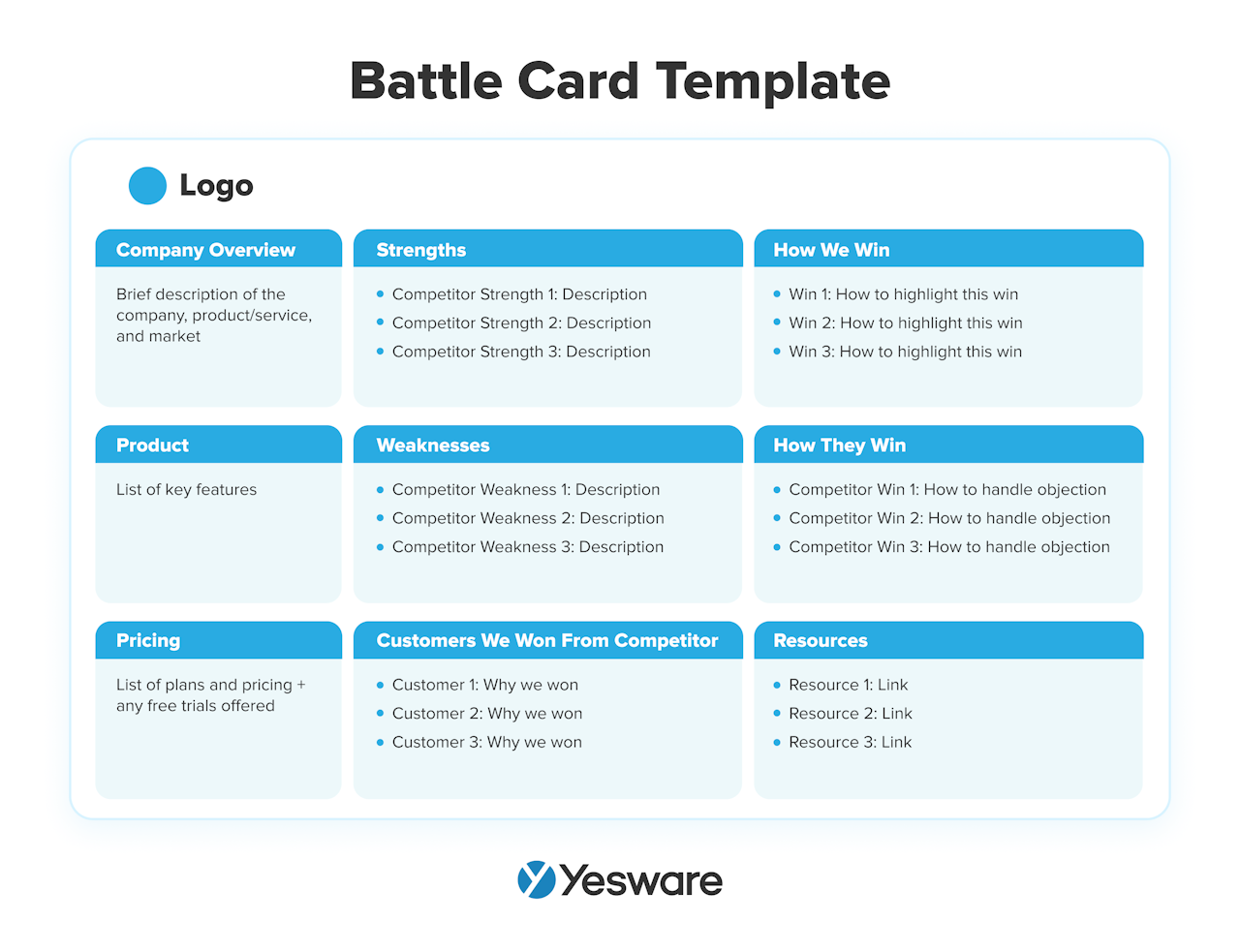 Battle cards exist to be a resource for salespeople to help them win deals. They can outline specifics about a competitor’s offerings or important information and unique selling propositions (USPs) that will help them be more persuasive to prospects.
Battle cards exist to be a resource for salespeople to help them win deals. They can outline specifics about a competitor’s offerings or important information and unique selling propositions (USPs) that will help them be more persuasive to prospects.
Why Battle Cards Are Important in Sales
Sales battle cards help sales reps with one of the most important parts of being a successful salesperson: preparedness.
Though they do require some time and effort to create, sales battle cards help sales teams improve their sales process and close rates: 71% of businesses who use them say they’ve increased win rates as a result.
Sales battle cards help sales reps stay ahead of the competition, prepare for productive conversations with prospects, and create better sales pitches.
Stay One Step Ahead
Battle cards help sales teams maintain an edge over the competition.
Most sales reps are busy enough with the day-to-day requirements of selling products; they don’t necessarily have time to track the goings-on with their competition. Competitive battle cards can help them stay in the loop.
For battle cards that are designed to highlight the competition, they need to be updated frequently to be effective. These kinds of battle cards help sales reps avoid being blindsided in the middle of sales conversations, so it’s important that they contain timely and accurate information.
Prepare for Customer Objections
The more you know about what your competition is doing, the better you can prepare for how they may play a part in your own sales conversions.
Sales objections relating to the competition are a natural part of many sales conversations, so it’s well worth it to study your battle cards ahead of time and prepare responses to common pain points.
Craft Better Pitches
Battle cards help sales reps design more effective sales pitches. The details on a sales battle card gives reps the information they need right at their fingertips. Battle cards can also be customized based on different buyer personas, which will help you further customize your pitch.
Sales battle cards collate the most useful, relevant information about your industry, product, and/or competition, and put it all in one convenient, easy-to-read spot.
Elements of a Winning Battle Card
Battle cards are inherently unique; the more customized they are, the more effective they become in the sales process.
That being said, there are some details that are useful for just about any type of sales battle card.
- Information about your company/product/service: For internal and customer-facing battle cards alike, it’s always a good idea to include more significant details about your own company’s product, service, or offer (including the features and benefits).
- Ideal customer profile (ICP) and buyer personas: Most battle cards will also be more complete with the inclusion of the ideal customer profile (ICP) and buyer personas. There may be more than one of these, so make one for each relevant subgroup of your market.
- Unique selling points (USPs) and differentiating factors: Your battle card should also include information that helps your sales reps understand why companies choose you over the competition. Make sure you have at least 3 differentiating factors prepared, and make sure they’re nuanced and impactful.
- Testimonials and use cases: It’s helpful to include information about recent wins or other relevant sales metrics that will help bolster your case with not-yet-signed prospects, such as real-life success stories, testimonials, and case studies. You’ll want to include details about how, specifically, your offer has solved similar problems in the recent, real-life past. This data should be a mix of qualitative and quantitative anecdotes.
- Industry trends: Some battle cards include information about recent industry or market trends/changes. This is especially important for offers that rely on market fluctuations to set their pricing. In certain industries, including information about trends, new players to the market, or government policies or regulations, can make or break the success of a deal on the line.
- Potential pitfalls: Some sales battle cards will also help sales reps prepare for potential pitfalls or challenges they are likely to encounter within the sales process. If sales reps know that they routinely encounter questions or objections around certain topics or competitors, it may be wise to include talking points around these on your battle cards.
- Competitor details: Some sales battle cards, especially those focused on the competition, need to include information about the competition’s strengths and weaknesses. This will help sales reps position themselves in a competitive market.
How to Create Battle Cards
Although battle cards’ name give them a reputation for being used in times of head-to-head conflict, they’re actually very beneficial for just about every sales team and every stage of the sales process.
Battle cards are used to help sales teams differentiate themselves from their competitors and help them clearly demonstrate their value.
If you’re interested in using battle cards in your sales process, the following steps can help you get started.
1. Talk to Your Salespeople
Battle cards — even the ones that are designed for prospects’ eyes — are designed primarily for salespeople’s benefit. They help sales reps organize and deliver their most important talking points during a sales meeting.
With that in mind, the first step in creating a sales battle card is to talk to your sales reps. In their experience, what information do they need at their fingertips during a sales meeting? Are they hung up on explaining product features? Do they feel particularly threatened by any one competitor? How do they feel they stand out most effectively against the rest of the market?
Regardless of the specifics, seek out feedback from your sales team about what information they need during high-stakes portions of the sales process.
2. Use Templates
Although sales battle cards are meant to be unique, it’s also okay to systemize the process of creating them, to the best of your ability.
If you can, create a battle card template, in which you can outline and standardize the generic portions and leave the specifics for fill-in-the-blank.
For many teams, this process works best when you create several templates for different buyer personas, products, or competitors.
The point is to try to find as much commonality as possible, format it into a template, and then customize the rest.
3. Pick Your Talking Points
It’s more than okay to be strategic about what you include on your sales battle cards. Highlights you might feature include: cost/pricing, return on investment (ROI), features/benefits, access to customer support, etc.
Remember that different battle cards can include different sets of different information, depending on what’s most persuasive to your different subgroups.
Remember to also consider whether specific battle cards will be used internally or among prospects. The information you include on competitive-based battle cards will be different than that you include on internal-only.
4. Choose Your Most Relevant Competitors
Only certain competitors hold weight when it comes to sales battle cards. Consider which competition comes up most often in conversation, and which most often beats you out when it comes to closing deals.
You may find that different competitors are more relevant during different stages of the buyer’s journey.
You may also find, depending on your battle card strategy, that some competitors deserve their own battle card, while others are fine sharing a multi-competitor card.
5. Do Your Research
As with everything in sales, successful battle cards require intense research. Sales battle cards are only effective if they’re accurate and updated in real-time. Research input should include competitor websites, online reviews, news article mentions, current account feedback, and more. The more you know and can include as part of your battle cards, the better.
Battle cards should also be a collaborative effort. They should be created and continuously updated by sales, marketing, customer success, sales enablement, and all other customer- and competitor-adjacent teams.
6. Update Your Content Regularly
Sales battle cards should be considered living, breathing documents. They are a resource that should be updated on an ongoing basis. This will help ensure that you stay up-to-date on your competitors and stay one step ahead.
Tip: Fill your sales battle card with words that’ll win prospects over.
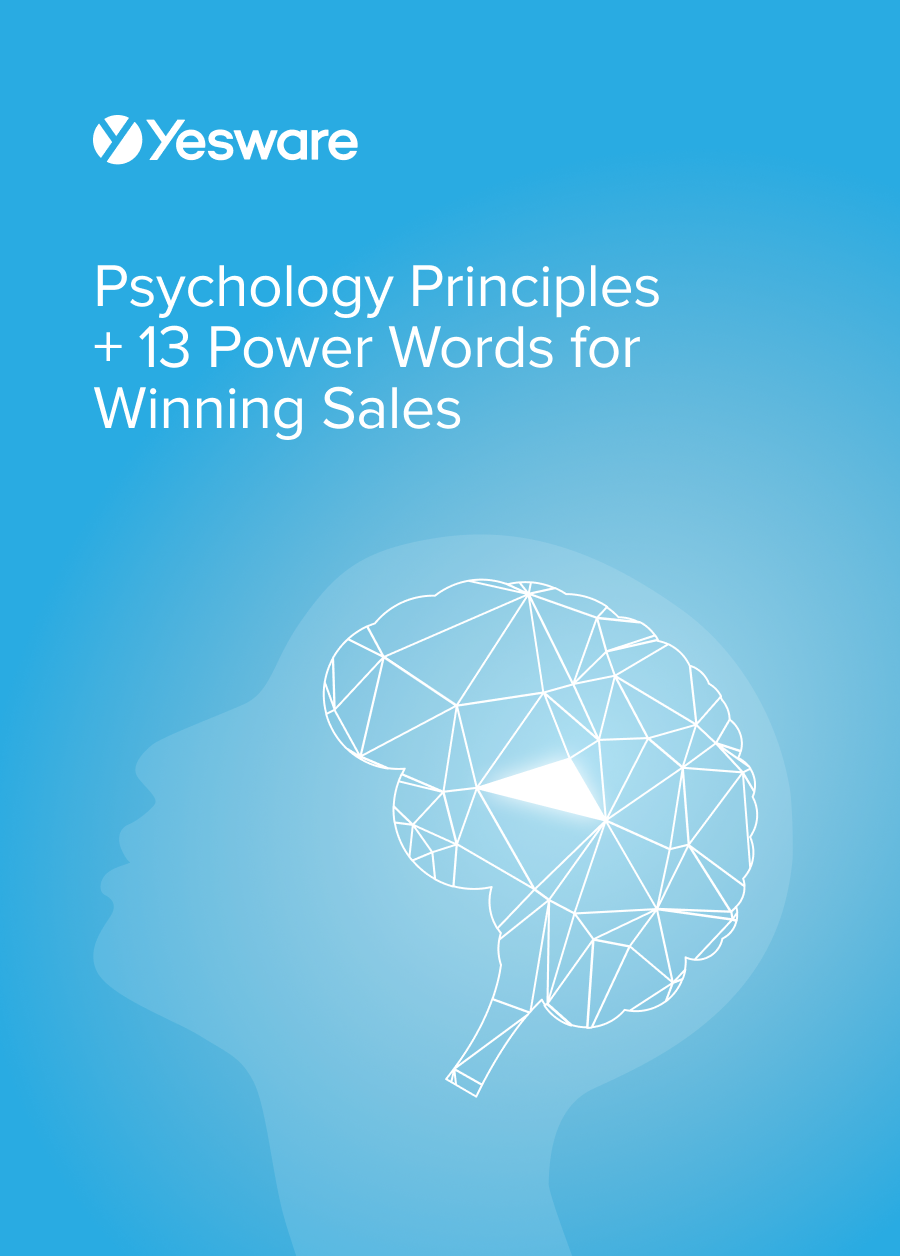 Psychology Principles + 13 Power Words for Winning SalesData-backed psychological principles, nonverbal cues, and persuasive phrases to win more deals.
Psychology Principles + 13 Power Words for Winning SalesData-backed psychological principles, nonverbal cues, and persuasive phrases to win more deals.
How to Use Battle Cards in Your Sales Process
Battle cards are unique, and each one should be used in the specific stage of the sale process where it will be most beneficial. There are no hard-and-fast rules about how and when to use them because that will be unique to your team and goals.
That being said, there are some general rules of thumb about where certain kinds of battle cards should be used.
One-to-one competitive analysis battle cards should be reserved for further down the sales pipeline when prospects are narrowly considering just a small selection of options. A detailed battle card against their top alternative competitor will help them whittle down their choices.
On the other hand, multi-competitor battle cards tend to be more generic, high-level, and more appropriate for higher up in the funnel. This is where they need a lot of basic information to help them categorize their options.
Regardless of their use case, battle cards should be easy to read and skimmable. They also need to be accurate and up-to-date.
Battle Card Examples
Here are a few of the most common types of battle cards.
Competitive Battle Cards
Competitive battle cards contain information about your organization’s main competitors. They might include details about their pricing strategy, offer specifics, their ICP and/or buyer personas, their market value, run rate, and more.
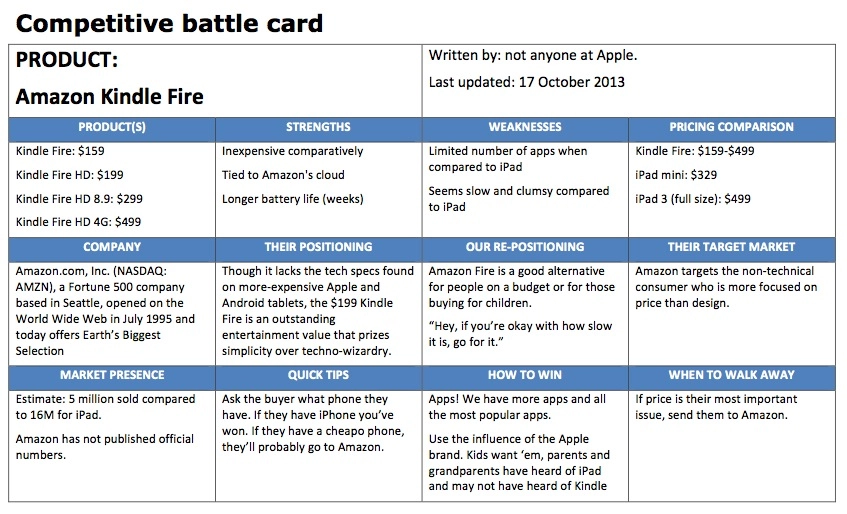
This kind of battle card can help sales reps swiftly handle objections during the sales process, and answer questions about how they’re better than other offers.
This kind of battle card is most effective when the information is actionable and easily demonstrable during a sales conversation.
Product Battle Cards
A product battle card is an educational tool for sales reps about their own product, service, or offer. It includes all the pertinent information sales reps might need to know in order to pitch their product.
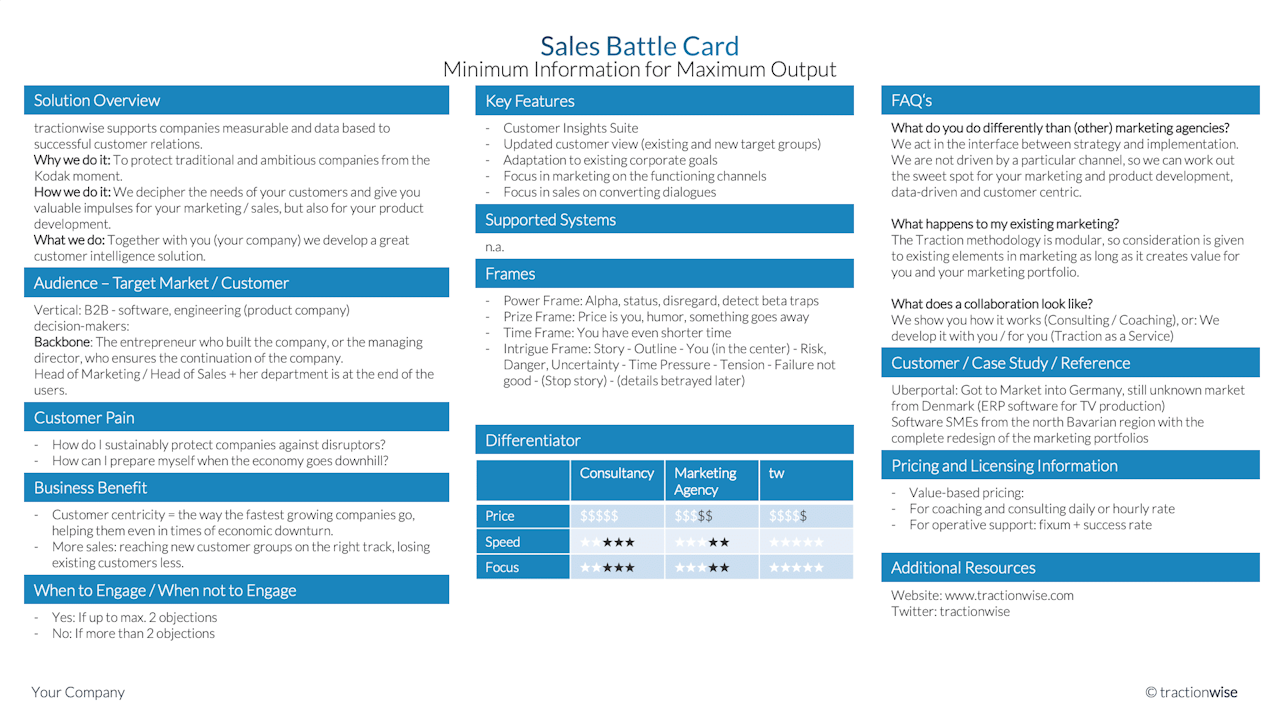
Product battle cards might also elaborate on prospect pain points, USPs, and special features. It’s often shown in infographic form and can focus on one product or be a comparison of several.
Marketing Battle Cards
A marketing battle card is, as you might suspect, specifically about a competitor’s marketing efforts. It details a competitor’s marketing strategy and helps sales reps understand to whom and how the competition is selling, so they can position themselves accordingly.
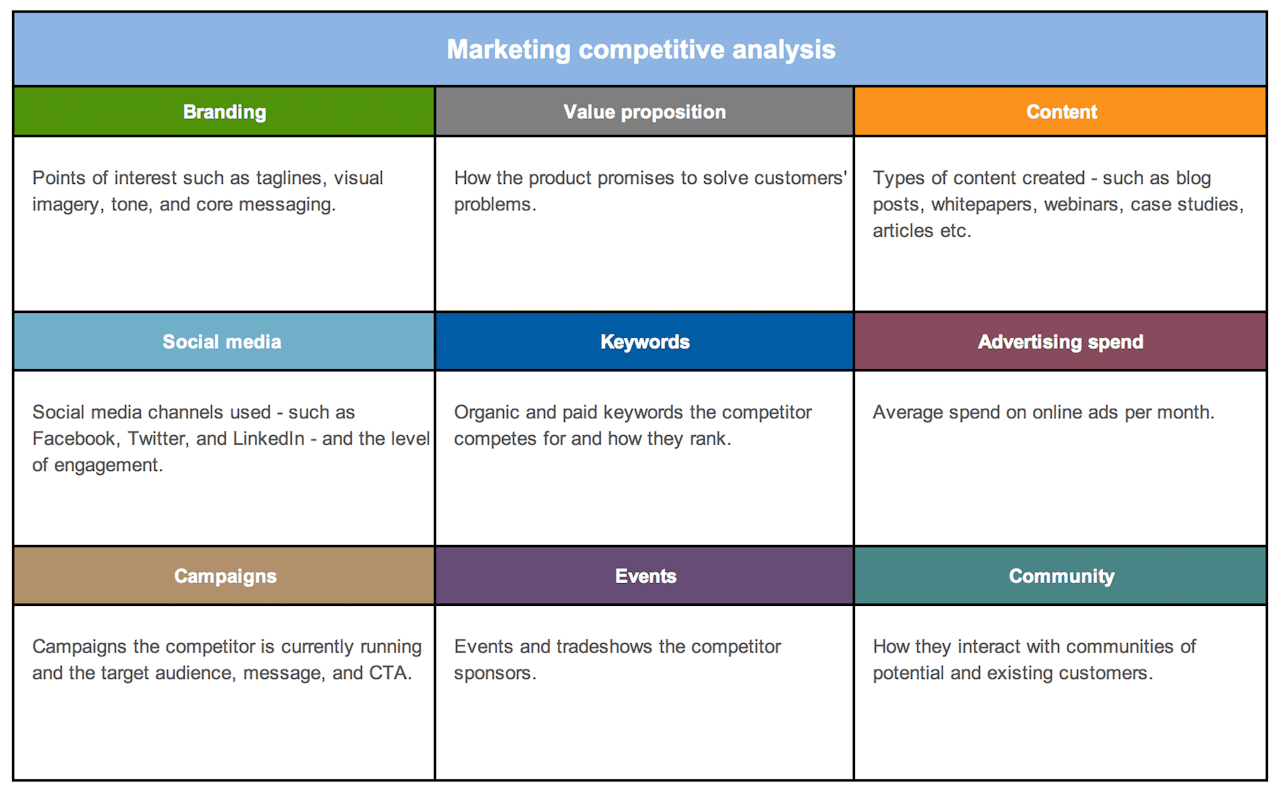
Comprehensive Battle Cards
Comprehensive battle cards are more high-level than some of their counterparts and are usually used earlier in the sales process when prospects are comparing several different options. They cover a lot of information on a single sheet.
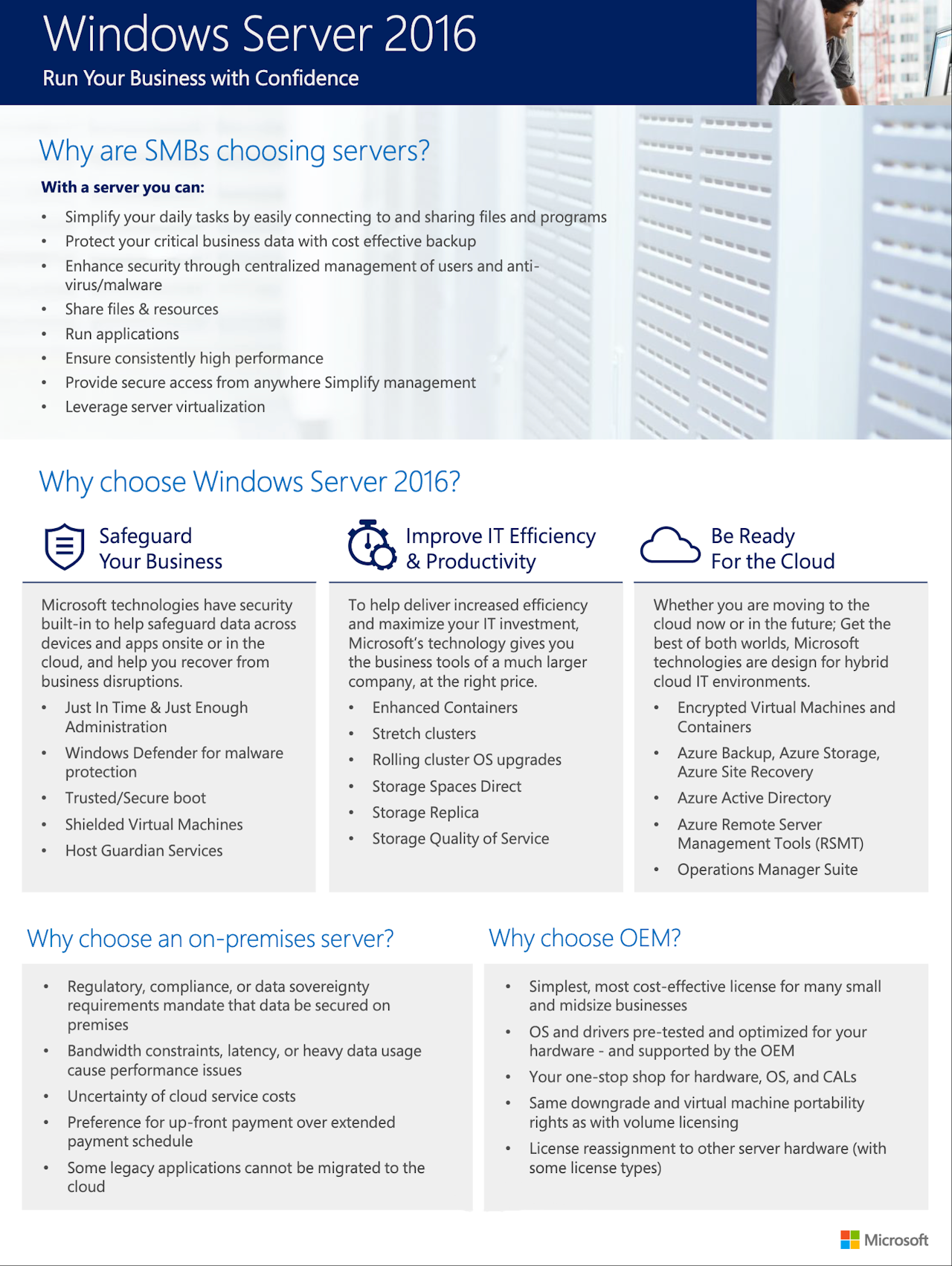
Question-Based Battle Cards
Some battle cards help sales reps stay prepared by outlining answers to any number of difficult questions they may encounter during the sales process. These kinds of sales battle cards help reps have productive conversations with prospects and helps them appear as an expert.

Does your team use sales battle cards? How do they enhance your sales practice? If you don’t, do you see an opportunity to benefit from battle cards?
Get sales tips and strategies delivered straight to your inbox.
Yesware will help you generate more sales right from your inbox. Try our Outlook add-on or Gmail Chrome extension for free, forever!
Related Articles
Casey O'Connor
Melissa Williams
Anya Vitko
Sales, deal management, and communication tips for your inbox

